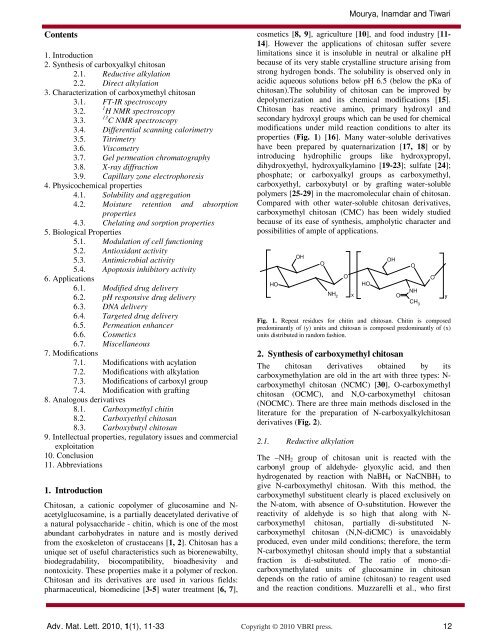Carboxymethyl chitosan and its applications - Advanced Materials ...
Carboxymethyl chitosan and its applications - Advanced Materials ...
Carboxymethyl chitosan and its applications - Advanced Materials ...
You also want an ePaper? Increase the reach of your titles
YUMPU automatically turns print PDFs into web optimized ePapers that Google loves.
Contents<br />
1. Introduction<br />
2. Synthesis of carboxyalkyl <strong>chitosan</strong><br />
2.1. Reductive alkylation<br />
2.2. Direct alkylation<br />
3. Characterization of carboxymethyl <strong>chitosan</strong><br />
3.1. FT-IR spectroscopy<br />
1<br />
3.2. H NMR spectroscopy<br />
3.3.<br />
13 C NMR spectroscopy<br />
3.4. Differential scanning calorimetry<br />
3.5. Titrimetry<br />
3.6. Viscometry<br />
3.7. Gel permeation chromatography<br />
3.8. X-ray diffraction<br />
3.9. Capillary zone electrophoresis<br />
4. Physicochemical properties<br />
4.1. Solubility <strong>and</strong> aggregation<br />
4.2. Moisture retention <strong>and</strong> absorption<br />
properties<br />
4.3. Chelating <strong>and</strong> sorption properties<br />
5. Biological Properties<br />
5.1. Modulation of cell functioning<br />
5.2. Antioxidant activity<br />
5.3. Antimicrobial activity<br />
5.4. Apoptosis inhibitory activity<br />
6. Applications<br />
6.1. Modified drug delivery<br />
6.2. pH responsive drug delivery<br />
6.3. DNA delivery<br />
6.4. Targeted drug delivery<br />
6.5. Permeation enhancer<br />
6.6. Cosmetics<br />
6.7. Miscellaneous<br />
7. Modifications<br />
7.1. Modifications with acylation<br />
7.2. Modifications with alkylation<br />
7.3. Modifications of carboxyl group<br />
7.4. Modification with grafting<br />
8. Analogous derivatives<br />
8.1. <strong>Carboxymethyl</strong> chitin<br />
8.2. Carboxyethyl <strong>chitosan</strong><br />
8.3. Carboxybutyl <strong>chitosan</strong><br />
9. Intellectual properties, regulatory issues <strong>and</strong> commercial<br />
exploitation<br />
10. Conclusion<br />
11. Abbreviations<br />
1. Introduction<br />
Chitosan, a cationic copolymer of glucosamine <strong>and</strong> Nacetylglucosamine,<br />
is a partially deacetylated derivative of<br />
a natural polysaccharide - chitin, which is one of the most<br />
abundant carbohydrates in nature <strong>and</strong> is mostly derived<br />
from the exoskeleton of crustaceans [1, 2]. Chitosan has a<br />
unique set of useful characteristics such as biorenewabilty,<br />
biodegradability, biocompatibility, bioadhesivity <strong>and</strong><br />
nontoxicity. These properties make it a polymer of reckon.<br />
Chitosan <strong>and</strong> <strong>its</strong> derivatives are used in various fields:<br />
pharmaceutical, biomedicine [3-5] water treatment [6, 7],<br />
Mourya, Inamdar <strong>and</strong> Tiwari<br />
cosmetics [8, 9], agriculture [10], <strong>and</strong> food industry [11-<br />
14]. However the <strong>applications</strong> of <strong>chitosan</strong> suffer severe<br />
limitations since it is insoluble in neutral or alkaline pH<br />
because of <strong>its</strong> very stable crystalline structure arising from<br />
strong hydrogen bonds. The solubility is observed only in<br />
acidic aqueous solutions below pH 6.5 (below the pKa of<br />
<strong>chitosan</strong>).The solubility of <strong>chitosan</strong> can be improved by<br />
depolymerization <strong>and</strong> <strong>its</strong> chemical modifications [15].<br />
Chitosan has reactive amino, primary hydroxyl <strong>and</strong><br />
secondary hydroxyl groups which can be used for chemical<br />
modifications under mild reaction conditions to alter <strong>its</strong><br />
properties (Fig. 1) [16]. Many water-soluble derivatives<br />
have been prepared by quaternarization [17, 18] or by<br />
introducing hydrophilic groups like hydroxypropyl,<br />
dihydroxyethyl, hydroxyalkylamino [19-23]; sulfate [24];<br />
phosphate; or carboxyalkyl groups as carboxymethyl,<br />
carboxyethyl, carboxybutyl or by grafting water-soluble<br />
polymers [25-29] in the macromolecular chain of <strong>chitosan</strong>.<br />
Compared with other water-soluble <strong>chitosan</strong> derivatives,<br />
carboxymethyl <strong>chitosan</strong> (CMC) has been widely studied<br />
because of <strong>its</strong> ease of synthesis, ampholytic character <strong>and</strong><br />
possibilities of ample of <strong>applications</strong>.<br />
Adv. Mat. Lett. 2010, 1(1), 11-33 Copyright © 2010 VBRI press. 12<br />
HO<br />
OH<br />
O<br />
NH 2<br />
O<br />
x<br />
HO<br />
OH<br />
O<br />
O<br />
NH<br />
CH 3<br />
Fig. 1. Repeat residues for chitin <strong>and</strong> <strong>chitosan</strong>. Chitin is composed<br />
predominantly of (y) un<strong>its</strong> <strong>and</strong> <strong>chitosan</strong> is composed predominantly of (x)<br />
un<strong>its</strong> distributed in r<strong>and</strong>om fashion.<br />
2. Synthesis of carboxymethyl <strong>chitosan</strong><br />
The <strong>chitosan</strong> derivatives obtained by <strong>its</strong><br />
carboxymethylation are old in the art with three types: Ncarboxymethyl<br />
<strong>chitosan</strong> (NCMC) [30], O-carboxymethyl<br />
<strong>chitosan</strong> (OCMC), <strong>and</strong> N,O-carboxymethyl <strong>chitosan</strong><br />
(NOCMC). There are three main methods disclosed in the<br />
literature for the preparation of N-carboxyalkyl<strong>chitosan</strong><br />
derivatives (Fig. 2).<br />
2.1. Reductive alkylation<br />
The –NH2 group of <strong>chitosan</strong> unit is reacted with the<br />
carbonyl group of aldehyde- glyoxylic acid, <strong>and</strong> then<br />
hydrogenated by reaction with NaBH4 or NaCNBH3 to<br />
give N-carboxymethyl <strong>chitosan</strong>. With this method, the<br />
carboxymethyl substituent clearly is placed exclusively on<br />
the N-atom, with absence of O-substitution. However the<br />
reactivity of aldehyde is so high that along with Ncarboxymethyl<br />
<strong>chitosan</strong>, partially di-substituted Ncarboxymethyl<br />
<strong>chitosan</strong> (N,N-diCMC) is unavoidably<br />
produced, even under mild conditions; therefore, the term<br />
N-carboxymethyl <strong>chitosan</strong> should imply that a substantial<br />
fraction is di-substituted. The ratio of mono-:dicarboxymethylated<br />
un<strong>its</strong> of glucosamine in <strong>chitosan</strong><br />
depends on the ratio of amine (<strong>chitosan</strong>) to reagent used<br />
<strong>and</strong> the reaction conditions. Muzzarelli et al., who first<br />
O<br />
y
















